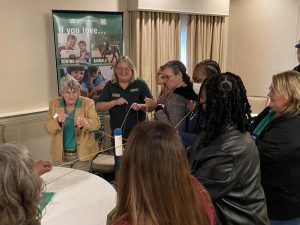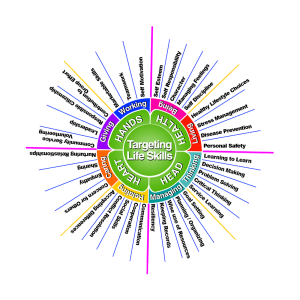Introduction
The goal of a 4-H program is for youth to learn about and develop life skills that will help them, in both the short term and long term, become contributors to their communities (Norman & Jordan, 2018). Life skills are the competencies or traits that relate to helping individuals’ function and navigate their lives.
When we begin planning 4-H programs with the end in mind, life skills are one of the considerations we should focus on. These skills should be identified during the planning process at the same time you are planning the objectives for each meeting. The life skills wheel illustrated in figure one serves as a tool to help visualize the most common life skills 4-H programs focus on. When we identify these skills, we can intentionally plan our programs to provide experiences that are specific and challenging without being overwhelming.
Often, we use projects and special interests as a hook to teach youth life skills. While some subjects are best suited to developing certain life skills, there are skills to be learned and developed no matter the exact subject being taught.
Getting Started
On the life skills wheel, all the life skills are categorized under the headings of head, heart, hands, and health which relates back to the 4-H pledge. By identifying the skills, you are targeting then planning activities to help you build those skills, you can build impactful programs that will continue to build on each other.
Let’s look at a scenario. We are working with a group of club officers at a training day preparing for the new 4-H year. The objectives for the meeting are for officers to learn their roles and for the youth learn more about each other so they are more comfortable working together. From here, we need to identify the skills we are hoping to build.
When you look at the life skills wheel there are numerous skills which could fit and be developed during this training. While some skills are built passively through experience, identifying three to five skills will help us identify activities and focuses that align with our objectives.

Picture 1: Volunteers participating in the bull ring activity at the 2023 NWD Volunteer Forum in Destin, Florida.
For this scenario, if we identify teamwork, problem-solving, communication, and planning/organizing as the life skills we intend to build, we need to identify activities that will build these skills. When working with activities we need to keep in mind that we need time for the do, reflect, apply model. So, once we do the activity, we need time for reflection, and a discussion on how we could apply what we have learned in the future.
If we look at this scenario a little bit closer, you will notice that some skills can be built during the same activity. An example of this would be if we were to use the bull ring activity, which has a tennis ball balanced on a ring by multiple strings are held by multiple participants standing in a circle as demonstrated in picture one, participants are going to use a bunch of life skills including communication, teamwork, problem-solving, and even planning. All these skills are necessary to successfully move the ball from point A to point B without dropping the ball. It is the intentional reflection and future application discussion of the skills that pulls in the impact and development of a skill beyond the passive learning that occurs.
Conclusion
4-H projects and meetings are an ideal environment for passive learning of life skills. However, it is the intentional planning of club and project leaders that results in active life skill development. So, as you are planning your next meeting, start with the end in mind. Identify your objectives and the life skills you want to develop, then intentionally plan activities and discussions which will lead youth through active thoughts and practice of the skills you are focusing on.
Resources
Hendricks, P. (1998). Developing youth curriculum using the targeting life skills model: Incorporating developmentally appropriate learning opportunities to assess impact of life skill development.
Norman, M., & Jordan, J. (2018, July 30). Targeting Life Skills in 4-H. https://edis.ifas.ufl.edu/publication/4H242
- Life Skills: Planning programs with the life skill wheel - March 31, 2023
- Fostering Experiential Learning in the Club Setting - October 12, 2022
- 2022 Area North Show - May 13, 2022

